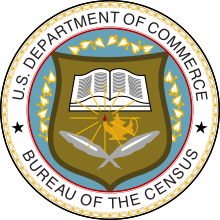| Twenty-first census of the United States | ||
|---|---|---|
| ||
 U.S. Census Bureau seal | ||
 | ||
| General information | ||
| Country | United States | |
| Results | ||
| Total population | 248,709,873 ( | |
| Most populous | California 29,760,021 | |
| Least populous | Wyoming 453,588 | |
The 1990 United States census, conducted by the Census Bureau, determined the resident population of the United States to be 248,709,873, an increase of 9.8 percent over the 226,545,805 persons enumerated during the 1980 census.[1]
Approximately 16 percent of households received a "long form" of the 1990 census, which contained more than 100 questions. Full documentation on the 1990 census, including census forms and a procedural history, is available from the Integrated Public Use Microdata Series.
It was the first census to designate "Native Hawaiian and Other Pacific Islander" as a racial group separate from Asians. The census was also the first census to be directed by a woman, Barbara Everitt Bryant.
To increase black participation in the 1990 United States census, the bureau recruited Bill Cosby, Magic Johnson, Alfre Woodard, and Miss America Debbye Turner as spokespeople.[2] The Integrated Public Use Microdata Series. Aggregate data for small areas, together with electronic boundary files, can be downloaded from the National Historical Geographic Information System. Personally identifiable information will be available in 2062.[3]
This was the first census since 1880 in which Chicago was not the second-largest city, having been overtaken by Los Angeles. As of the 2020 census, Los Angeles has remained the nation's second-largest city.
- ^ "Population and Area (Historical Censuses)" (PDF). United States Census Bureau. Archived (PDF) from the original on June 24, 2008. Retrieved June 20, 2008.
- ^ Brown, Frank Dexter (February 1990). "The 1990 Census: Will Blacks Be Counted Out?". Black Enterprise. 20 (7). Earl G. Graves, Ltd: 195. ISSN 0006-4165. Retrieved July 29, 2011.
- ^ "The "72-Year Rule" – History". U.S. Census Bureau. Retrieved October 26, 2015.